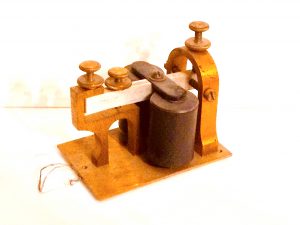Can you guess what this object is — and what it does?
Hint: The answer is at the bottom of this webpage.
SCROLL DOWN TO SEE THE ANSWER …
>
>
>
>
>
>
>
>
>
>
>
>
>
>
>
>
>
>
>
>
>
>
>
>
>
>
>
>
>
>
>
ANSWER to the “What the Heck IS This Thing #10?” Game:
This is vintage telegraph sounder.
Telegraph networks, used from the 1850s to the 1920s to transmit text messages long distances, transmitted information by pulses of current of two different lengths, called “dots” and “dashes” which spelled out text messages in Morse code. A telegraph operator at the sending end of the line would create the message by tapping on a switch called a telegraph key, which rapidly connects and breaks the circuit to a battery, sending pulses of current down the line.
The telegraph sounder was used at the receiving end of the line to make the Morse code message audible. Its simple mechanism was similar to a relay. It consisted of an electromagnet attached to the telegraph line, with an iron armature near the magnet’s pole balanced on a pivot, held up by a counterweight. When current flowed through the electromagnet‘s winding, it created a magnetic field which attracted the armature, pulling it down to the electromagnet, resulting in a “click” sound. When the current ended, the counterweight pulled the armature back up to its resting position, resulting in a “clack” sound. Thus, as the telegraph key at the sending end makes and breaks the contact, the sounder echoes the up and down state of the key.
It was important that a sounder make a sound both when the circuit was broken and when it was restored. This was necessary for the operator to clearly distinguish the long and short keypresses – the “dashes” and “dots” – that make up the characters in morse code.
https://en.wikipedia.org/wiki/Telegraph_sounder
Support Our Mission
The Lovettsville Historical Society is a nonprofit organization that relies entirely on volunteer help. Support our mission to preserve and protect the history of Lovettsville, The German Settlement, and our unique corner of Loudoun County, Virginia. Purchase a membership or make a tax-deductible* donation today.
Visit us on the web at www.LovettsvilleHistoricalSociety.org.
Visit the Lovettsville Museum, open Saturdays 1:00-4:00 or by appointment, at 4 East Pennsylvania Avenue, next to Lovettsville Town Hall. GoogleMap It
Subscribe to our free monthly electronic Lovettsville History Magazine: http://lovettsvillehistoricalsociety.us8.list-manage2.com/s…
Join us and support our mission to preserve local history. https://squareup.com/store/lovettsville-museum/
* The Lovettsville Historical Society, Inc. is a tax-exempt 501(c)(3) organization under the Internal Revenue Code. Contributions and membership dues are tax deductible under Internal Revenue Code Section 170.



